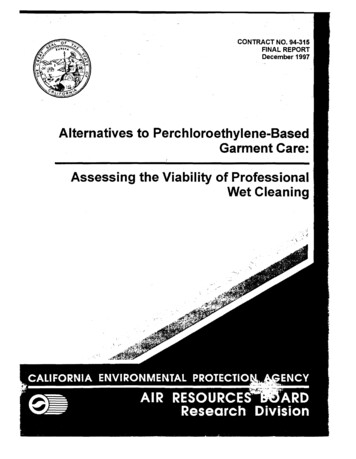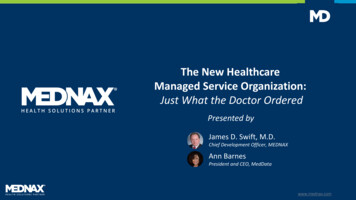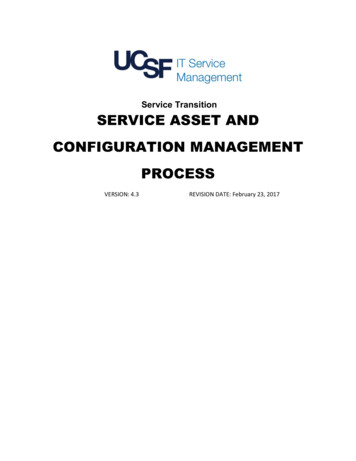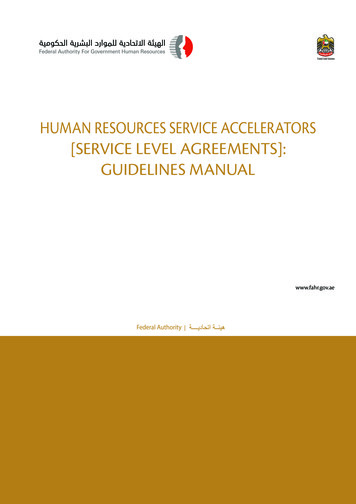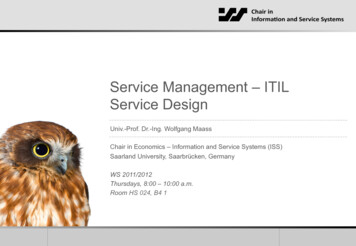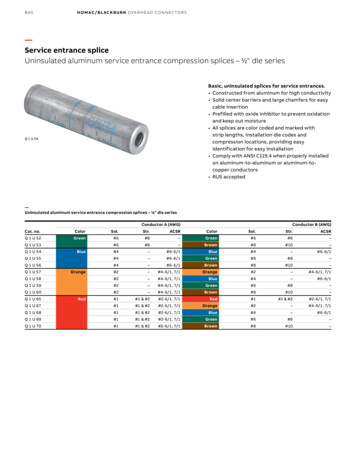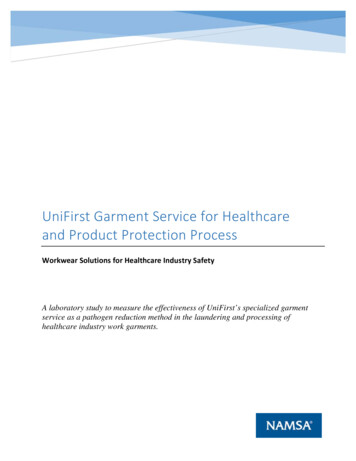
Transcription
UniFirst Garment Service for HealthcareUniFirst Garment Service for Healthcareand Product Protection ProcessWorkwear Solutions for Healthcare Industry SafetyA laboratory study to measure the effectiveness of UniFirst’s specialized garmentservice as a pathogen reduction method in the laundering and processing ofhealthcare industry work garments.
Table of ContentsHealthcare Safety Background 2UniFirst Garment Service for Healthcare 3Laboratory Tests . 6Test System Development . . 7Feasibility Study . 8Feasibility Study Results . . 8UniFirst Testing Strategy . . 9UniFirst Process Testing . . 12UniFirst Process Testing Study Results . 12Poly‐Wrap Garment Bag Effectiveness Testing and Results 17Conclusions . . 19Endnote . . . 19About NAMSA . . 19Definitions . 201
Healthcare Safety BackgroundContamination control is one of the major challenges the healthcare industry faces today, andorganizations of all types and sizes are actively seeking solutions. The risk of healthcare-associatedinfections (HAIs) increases each year, with antibiotic-resistant organisms, such as MRSA, on the rise.Each year, nearly 2 million Americans develop some form of a healthcare-acquired infection, most due toan antibiotic-resistant organism. While there may not be one comprehensive solution, there are manydifferent strategies that can be implemented as preventive measures. Preventive measures are critical tohelp reduce contamination and risk of infection. Improved attention toward hygiene practices, especiallyhand cleaning and sanitizing, is one of the major steps that have been implemented within the healthcareindustry to help combat contamination threats. Another important preventive measure is ensuring thecleanliness of all reusable apparel worn by healthcare industry workers. Items such as lab coats andscrubs are exposed to contamination on a daily basis and need to be hygienically laundered and processedin order to help reduce contamination levels within healthcare environments.Reducing HAIs not only helps improve the overall patient outcomes of a healthcare facility, but it also hasa positive impact on the bottom line. According to the Centers for Disease Control and Prevention (CDC),HAIs cost the healthcare industry approximately 45 billion annually1. In addition, legislation such as theAmerican Recovery and Reinvestment Act of 2009 and the Patient Protection and Affordable Care Act of2010 incorporate funding incentives for reduced HAIs and financial penalties for facilities reporting highHAIs.The presence of diseases contaminating organisms in healthcare environments is a main contributor toHAIs that may cause longer hospital stays and higher costs affecting patients and insurers alike. The CDCand healthcare institutions are cognizant of this fact, and track and periodically report on HAIs. Thefollowing are the results of a large surveillance study conducted for HAI’s from 2006–20072.Overall, 463 hospitals reported one (1) or more HAIs: 412 (89%) were general acute care hospitals, and 309 (67%) had 200–1,000 beds. Some patients acquired more than one (1) organism, as there were 28,502 HAIs reported among 25,384 patients.The 10 most common pathogens (accounting for 84% of any HAIs) were coagulase-negative staphylococci (15%),Staphylococcus aureus (15%), Enterococcus species (12%), Candida species (11%), Escherichia coli (10%), Pseudomonasaeruginosa (8%), Klebsiella pneumoniae (6%), Enterobacter species (5%), Acinetobacter baumannii (3%), and Klebsiellaoxytoca (2%). The pooled mean proportion of pathogenic isolates resistant to antimicrobial agents varied significantly acrosstypes of HAI for some pathogen-antimicrobial combinations. As many as 16% of all HAIs were associated with the followingmultidrug-resistant pathogens: methicillin-resistant S. aureus (8% of HAIs), vancomycin-resistant Enterococcus faecium (4%),carbapenem-resistant P. aeruginosa (2%), extended-spectrum cephalosporin-resistant K. pneumoniae (1%), extendedspectrum cephalosporin-resistant E. coli (0.5%), and carbapenemresistant A. baumannii, K. pneumoniae, K. oxytoca, and E.coli (0.5%). Nationwide, the majority of units reported no HAIs due to these antimicrobial-resistant pathogens.The rationale for the organisms that have been chosen for this study is based on the prevalence and typesof organisms most commonly associated with these HAIs. The organisms have been categorized based onbacteriological characteristics and the laboratory’s ability to safely handle and work with the specifiedorganisms.1 The Direct Medical Costs of Healthcare Associated Infections in U.S. Hospitals and the Benefits of Prevention. Division ofHealthcare Quality Promotion, Centers for Disease Control. R. Douglas Scott II, March 2009.2 Antimicrobial-Resistant Pathogens Associated With Healthcare-Associated Infections: Annual Summary of Data Reported tothe National Healthcare Safety Network at the Centers for Disease Control and Prevention, 2006–2007. Infection Control andHospital Epidemiology November 2008, vol. 29, no. 112
UniFirst Garment Service for HealthcareIn order to effectively minimize potential contamination, work garments worn by healthcare employeesneed to be specially maintained, processed, and managed. To address these needs, UniFirst Corporation, auniform service and supply company operating throughout the U.S. and Canada, developed its specializedUniFirst Garment Service for Healthcare, specifically designed to reduce potential bacterial contaminantsthat could be associated with soiled healthcare employee workwear.UniFirst Garment Service for Healthcare includes a portal-to-portal process, called the Product ProtectionProcess (PPP), designed to minimize cross-contamination risks on delivered goods from uniforms andother work apparel. The UniFirst PPP begins at customer facilities where all soiled garments are collectedand sorted following Universal Precautions. Garments are then further segregated upon arrival at theUniFirst processing plant (also following Universal Precautions), then laundered to meet healthcare safetyspecifications, steamed and/or pressed, and poly-bagged (optional) for delivery. All processing followsdefined UniFirst healthcare garment Standard Operating Procedures (SOPs), which address the CriticalControl Points (CCPs) and processing steps associated with contamination risks. In the end, UniFirstconsistently delivers hygienically clean garments to its healthcare industry customers on a regularschedule.This proprietary healthcare uniform program was developed following healthcare laundering guidelines setforth by the CDC (Guidelines for Environmental Infection Control, 2003), OSHA’s guidelines for handlingbiologically contaminated laundry (Bloodborne Pathogens Standard, 1910.1030), and Universal Precautionsfor Preventing Transmission of Bloodborne Infections. UniFirst Garment Service for Healthcare has beeninstituted in UniFirst servicing plants, and UniFirst personnel involved receive detailed training on the uniquesafety requirements of these types of accounts. The detailed steps in UniFirst’s process are identified in thefollowing flow chart.3
UniFirst Product Protection Process (PPP)The UniFirst Product Protection Process has three (3) primary stages (annotated bycontamination is eliminated as indicated with stars in the flow chart above.) where microbial1. Specialized healthcare wash cycle2. Dryer cycle3. Steam tunnel finishing/garment pressing cycleThe optional poly-wrap stage is an additional preventive measure to help protect cleaned garments fromexposure to environmental contaminants after processing, throughout the delivery process, and prior tobeing worn. Once the garments have gone through the full PPP, they are packaged and loaded onto adelivery vehicle and transported to the UniFirst customer.Garment laundering service begins with the delivery of hygienically clean garments and the pickup ofsoiled ones from the customer facility. Soiled garments are brought to the transport vehicle and loadedinto segregated plastic liners. Soiled items are then transported to a UniFirst processing facility to undergo4
the complete Product Protection Process that, in addition to drying, steam tunnel/pressing, and otherimportant steps associated with the process, includes four (4) defined CCPs:CCP 1 – Soiled garments segregated and stored in slings/hampers; staged in preparation for washingCCP 2 – Garments undergo UniFirst’s specialized healthcare wash processCCP 3 – 10-point quality inspection of all garments (with processes to address any flaws that could puthealth safety at risk; e.g., apparel damage, fabric shedding, loose buttons, etc.)CCP 4 – Finished garments prepared for redelivery (poly-wrapped, if desired), consistent with customerrequirementsUniFirst Garment Service for Healthcare Processing Steps:1. Loading the route vehicle for delivery – Truck loaded with appropriate segregation containers,bags, and hygienically clean garments.2. Delivery of clean garments – Hygienically clean (poly-wrapped, if desired) garments aredelivered to designated area at customer site.3. Pickup of soiled garments – Soiled garments are placed in plastic bags and put on route truck insegregated containers/bins.4. Return to UniFirst processing facility (plant) – Soiled garments are transported to a UniFirstindustrial laundry plant.5. Unloading soiled garments – Garments are sorted, identified as “healthcare industry-related,”and segregated using designated slings.6. Washing and drying – Slings loaded with identified “healthcare industry-related” soiledgarments are brought to wash aisle and hygienically laundered with a specified wash process andcleaning formula. After the wash cycle, items are loaded into dryers for moisture removal andgarment conditioning.7. Inspection and garment finishing – All hygienically clean garments undergo 10-point qualityinspections; garments passing inspection go through a high temperature steam tunnel or garmentpress. Garments failing inspection are routed for mending or replacements and go through thecomplete Product Protection Process again.8. First sort – All garments are segregated and sorted by delivery schedule, customer, and wearerusing proprietary bar code scanning technology.9. Final delivery of hygienically clean garments – Finished, sorted garments (optionally polywrapped) are segregated and transported from plant to designated site at customer location orUniFirst branch for final customer delivery.5
Laboratory TestsTo measure the effectiveness of UniFirst Garment Service for Healthcare, we needed to determine if it isan effective pathogen-reduction methodology in the laundering and processing of healthcare workgarments. To scientifically measure this, UniFirst turned to North American Science Associates Inc.(NAMSA) for an objective laboratory study.NAMSA is a microbiology consulting service and Good Manufacturing Practice (GMP) testinglaboratory with expertise in contamination controls for the medical device industry. NAMSA developedand executed formal protocols based on scientific laboratory methods to assess the microbiologicalcontamination controls used by UniFirst in its Garment Service for Healthcare. The study was based onthe guidelines set for controlling biocontamination on garments in laundering processes: ISO 14698Annex D and E Biocontamination Control of Laundry Services, a guidance document for cleaningvalidations of reusable medical devices; AAMI TIR12:2010 Designing, testing, and labeling reusablemedical devices for reprocessing in health care facilities: a guide for medical device manufacturers, aguidance document for culturing microbial organisms; ANSI/AAMI/ISO 11737-1:2006/(R)2011 –Sterilization of healthcare products – Microbiological methods – Part 1: Determination of the populationof microorganisms on product and applicable General Chapters of the United States Pharmacopeia (USP),and FDA healthcare safety guidelines and requirements.The following is a summary of the studies conducted by NAMSA to evaluate the ability of UniFirstGarment Service for Healthcare to reduce and control microbial contamination during the laundering,processing and delivery, including a poly-wrap bag option, for healthcare industry work garments.Example healthcare garment items include soiled uniforms, soiled scrubs, and laboratory coats. Bacterialcross-contamination from all of these sources is a known cause of concern for both UniFirst and its manyhealthcare industry customers. This scientific laboratory analysis was commissioned by UniFirst toquantify pathogen reductions within the company’s specialized garment service, Product ProtectionProcess, and optional poly-wrap garment protection bag.6
Test System DevelopmentIn order to correctly assess the microbial reduction power of UniFirst Garment Service for Healthcare andProduct Protection Process, the testing needed to be conducted on healthcare industry relevant organisms.However, wild type organisms are difficult to work with and can be dangerous to laboratory personnel.Therefore, using laboratory controlled organisms of similar types as the wild type is the preferred, safe,and effective method to demonstrate the microbial reduction power of the UniFirst PPP.The rationale for the organisms that were chosen for this study was based on the organisms mostcommonly associated with HAIs. The organisms were categorized based on bacteriological characteristicsand the laboratory’s ability to safely handle and work with the organisms. See Table 1 for selection oforganisms used in this study.Not only did the appropriate organisms have to be determined, but the garments used in the test had to beselected based on their ability to capture a majority of the related challenges garments could pose to thelaundering system. In the end, an 80/20 polyester/cotton poplin blend was chosen because it is one of themost commonly used garments in the healthcare industry.Table 1SelectedOrganismOrganism ClassificationRelatedOrganismsGram StainReactionGrowthCharacteristicsEscherichia Catalase positiveorganismsEnterococcus,Listeria (rodshaped)Gram positiveaerobicPseudomonasaeruginosaNon-enteric, illusaerobicCandida albicansYeast(Saccharomycetes)CrytococcusGram positiveaerobic7
Feasibility StudyA feasibility study was designed to evaluate the viability of populations of various healthcare industryrelated and clinically relevant vegetative organisms (Pseudomonas aeruginosa, Staphylococcus aureus,Escherichia coli and Candida albicans)3 directly inoculated ontogarment swatches that were attached to new, full-size healthcareindustry-style garments (Figure 1). This was necessary becausevegetative organisms cannot survive for extended periods of time afterinoculation on the test articles due to cellular dehydration. The datawould demonstrate organism viability for a potential timeline of12 hours from sample preparation to transportation to UniFirst(where they would be exposed to the garment processing steps),then transportation back to the lab where the test swatches would becultured for determination of microbial reduction. In order toaccurately assess the microbial reduction power of UniFirst GarmentService for Healthcare and the steam tunnel process, it was necessaryto make sure these processes were reducing the organisms and notcellular dehydration. The feasibility study determined how long thetest organisms inoculated on the swatches were able to survive.Figure 1Feasibility Study ResultsThe feasibility study results demonstrated the inoculated garments needed to be kept cool in order toprevent organism die-off; therefore, the inoculated garments would need to be transported in coolers toand from the UniFirst processing facility. The feasibility study results also demonstrated thatPseudomonas aeruginosa was not a suitable organism for use in the test, as it did not survive theminimum 12-hour viability challenge time. It also demonstrated that these organisms, if present ongarments used in the field, would not survive on garments once they are no longer on their host (i.e.,person wearing the garment or the wet processing environment) due to cellular dehydration or die-off.Taking into account the results of the feasibility study, the actual comprehensive study was designed andconducted as follows.3Centers for Disease Control and Prevention; Healthcare-associated Infections (HAIs) http://www.cdc.gov/HAI/index.html8
UniFirst Testing StrategyThe study was designed with (1) accuracy, (2) precision, (3) selectivity, (4) sensitivity, (5) stability, and(6) reproducibility in mind. The UniFirst Garment Service for Healthcare study is illustrated in theflowcharts below.UniFirst Garment Service for Healthcare Wash ProcessUniFirst delivered new representative healthcare industry garments to NAMSA.NAMSA autoclaved the garments to eliminate any potential microbial test interference.NAMSA cut swatches, attached the swatches to garments, and inoculatedthe swatches with a population of 108 CFU of test organisms.NAMSA delivered the garments to UniFirst service plant incoolers in order to preserve the organisms on the swatches.UniFirst processed the garments with NAMSA‐inoculated swatchesusing the defined UniFirst Garment Service for Healthcare.Garments were collected by NAMSA at the end of the UniFirst Garment Service forHealthcare wash cycle. The laundered garments were placed into sterile bags, andthe bags were placed in coolers in order to preserve any surviving organisms thatwere not inactivated by the UniFirst Garment Service for Healthcare wash cycle.NAMSA recovered any surviving organisms on the garments usingmethods specified in ISO‐11737‐1:2006/(R)2011.9
UniFirst GMP Study for Steam Tunnel ProcessUniFirst delivered a new set of representative healthcare industry garments to NAMSA.NAMSA autoclaved the garments to eliminate any potential microbial test interference.NAMSA cut swatches, attached the swatches to garments, andinoculated the swatches with a population of 108 CFU of test organisms.NAMSA delivered the garments to UniFirst service plant incoolers in order to preserve the organisms on the swatches.UniFirst processed the garments with the NAMSA‐inoculatedswatches using high temperature steam tunnel exposure.Garments were collected by NAMSA at the end of the steam tunnel process.The steam‐processed garments were placed into sterile bags and the bags werereturned to coolers in order to preserve any surviving organisms that were notreduced by the steam tunnel exposure.NAMSA recovered any contamination on the garmentsusing methods specified in ISO‐11737‐1:2006/(R)2011.10
The microbiological tests conducted were designed to assess the microbial load reduction capabilities ofUniFirst Garment Service for Healthcare and Product Protection Process, as well as garment deliverycross-contamination prevention with optional poly-wrap garment bags. The tests conducted represent anexaggerated contamination scenario, as garment samples were inoculated with excessive quantities ofbacteria (approximately 100 million organisms). Fabric swatches were used to localize the bacterialinoculation, and to make laboratory sampling as accurate and reproducible as possible. The swatches werecut from extra garments provided, made of the same materials as their host garments, in order to remainconsistent with the routine garment materials. Three (3) indicator organisms were chosen to represent thedifferent types of bacterial and fungal pathogens that are common so
UniFirst Garment Service for Healthcare includes a portal-to-portal process, called the Product Protection Process (PPP), designed to minimize cross-contamination risks on delivered goods from uniforms and other work apparel. The UniFirst PPP begins at customer
